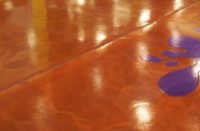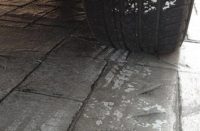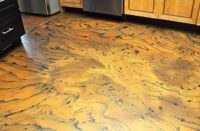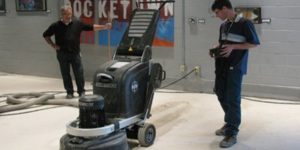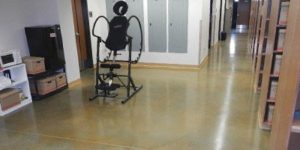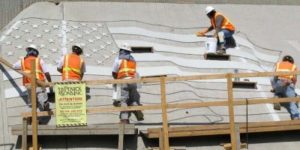
I typically try to avoid writing on the same subject within three years because there’s more than enough “fresh” material concerning decorative concrete to address. But, certain subjects come up more often and warrant a refresher or update.
Slip and fall protection, and how it relates to sealers and coatings, is one of those subjects. I don’t have a question to answer this time; I have a topic to address. This piece is more about defining slipperiness and the testing methods used to evaluate the slipperiness of sealers and coatings.
The issue of slip and fall within our industry, and in general, is very relevant to anyone installing sealers or coatings and warrants extra attention. According to the U.S. Department of Labor’s Occupational Safety & Health Administration (OSHA), “Slips, trips and falls account for 15 percent of all accidental deaths, and are second only to motor vehicles as a cause of fatalities,” notes Don Ostrander, CSP, director of consulting services occupational safety and health at the National Safety Council in Itasca, Illinois. In 2014, there were 822 occupational deaths due to falls.
That relevance holds true for both commercial and residential work. In fact, I find most of the questions and complaints I get on the subject come from homeowners or owners of small commercial projects who had stamped or stained concrete where the sealer is slippery. Larger commercial projects tend to go through a designer or architect that looks for ADA and OSHA compliance when specifying sealers and coatings. When you think about it, this makes sense since architects’ reputations and bank accounts are on the line if they are found negligent for a product they specified that led to a slip and fall issue.
I find residential and small commercial installations have gotten better at educating owners and/or taking steps to reduce slip issues, but far more can and should be done. In researching this article, I was surprised at the annual cost of slip and fall injuries. According to the 2006 Liberty Mutual Workplace Safety Index, the annual direct cost of disabling occupational injuries due to slips, trips and falls is estimated to exceed $11 billion. When you do the math that works out to a $31 million-per-day problem.
Defining coefficient
Now that we have some numbers, let’s look at the mechanism behind the problem as it relates to our industry. Slips and falls are actually two very different things. When you slip, you lose your balance and slide on a floor. When you fall, you move from one level to another. When talking about decorative concrete sealers, we deal with slips, not falls. The mechanism behind slips all comes down to friction, more specifically the coefficient of friction (CoF).
By definition, CoF is a value that shows the relationship of the force of friction between two objects and the normal force between the objects. To simplify, you get a number that shows the difference in friction between two objects (foot and floor) when standing still as compared to moving past each other.
The value ranges from 0 to 1. A value of 0 means no friction: Two objects slide very easily past each other. A value of 1 means lots of friction: Two objects don’t move easily past each other. As a side note, a value of 0 is theoretical, as all objects that touch exert some friction force upon each other.
Let’s see how this relates to the real world. When I walk across an icy parking lot with my 25-year-old, well-worn-leather cowboy boots I produce a very low coefficient of friction and run a high risk of ending up on my back. In contrast, when my much smarter wife walks across the same icy parking lot with her textured, rubber-soled Ugg Boots, she produces a much higher coefficient of friction and easily walks by me as I lay on my back in pain. Of course this is an oversimplified example, and there are many other factors, like mass and speed of the objects that contribute to the coefficient number, but you get the idea.
When it comes to testing and standards, there are no mandatory standards for CoF! There are recommendations and accepted values, but nowhere does the government state the CoF has to be a certain value for a certain flooring application. OSHA’s “General Requirements for Walking and Working Surfaces” state the recommendations for static CoF. OSHA standards for flooring roughness are not mandatory and are based upon a study done by the University of Michigan and reported in “Work Surface Friction: Definitions, Laboratory and Field Measurements, and a Comprehensive Bibliography.”
The generally accepted standard from OSHA is 0.5, while the Americans with Disabilities Act (ADA) recommends the CoF be raised to 0.6, but that remains a suggestion, not a law. Keep in mind that having CoF values too high also can pose a safety issue.
Turn to ASTM and ANSI tests
A 2003 report by the Society for Protective Coatings states that flooring with a high static coefficient of friction (SCoF), 0.8 to 1.0, is actually more of a slip and fall hazard because the roughness of the surface can catch the sole of footwear and cause the person walking on the surface to trip and fall. This means that the target value for CoF is between 0.5 and 0.8 — not a very big window.
Another factor to consider is there are two types of CoF. Static CoF is the value generated when an object starts moving (starts walking from standing still), where dynamic or kinetic CoF is the value generated when two objects in contact are moving past each other (walking across a surface).
How are CoF values and recommendations determined? Many machines have been created to measure it. Testing companies use these machines’ results to create recommendations and standards that other agencies follow. ASTM and ANSI are the most recognized testing companies, and many government regulations are based upon their standards.
ASTM and ANSI are international standards organizations that develop and publish technical standards for various items. Four types of ASTM tests and one type of ASNI test are done for flooring: ASTM 1679, ASTM E303, ASTM D2047, ASTM F1677 and ANSI A137.1 which replaced ASTM C1028. Space won’t allow me to outline each test in detail, but when it comes to slip issues concerning sealers and coatings for decorative concrete, I recommend using products that meet ASTM 1679 or ANSI A137.1. Both tests are designed to generate a static and dynamic CoF value for almost all surface types, as well as wet or dry, flat or incline.
Visit the ASTM and ANSI websites for more information. It’s important to note that many sealers and coatings meet the recommended CoF value when dry, but do not when wet. This is usually remedied by adding one of the many grit additives on the market to the sealer being applied. For more on that, visit bit.ly/1mTNZvA to read the Concrete Decor April 2014 article titled, “How Can You Minimize Sealer Slipperiness?”
